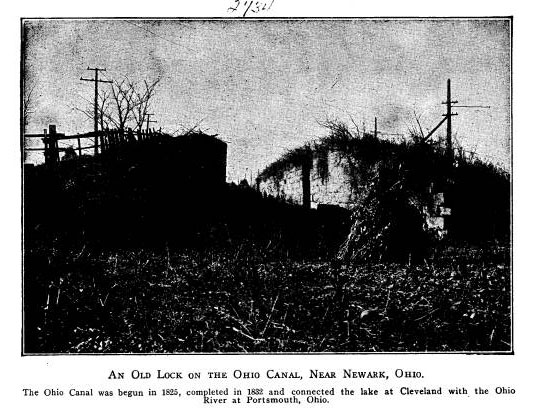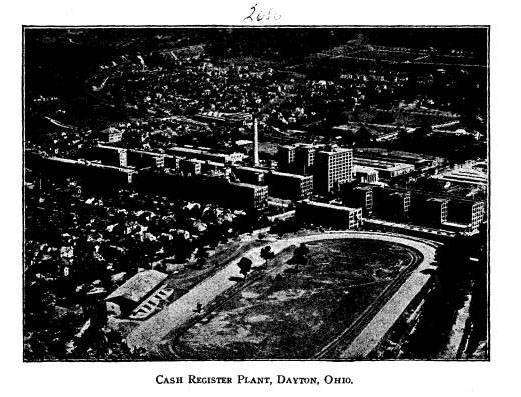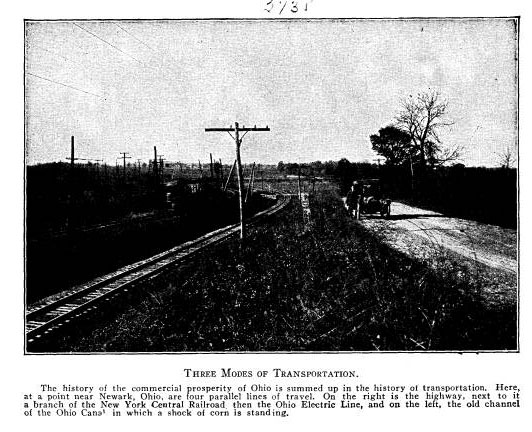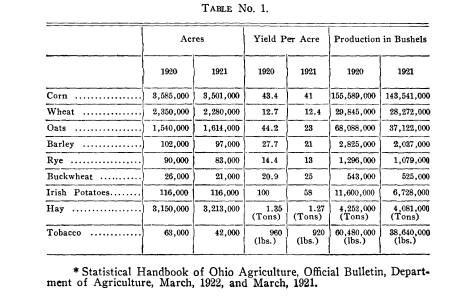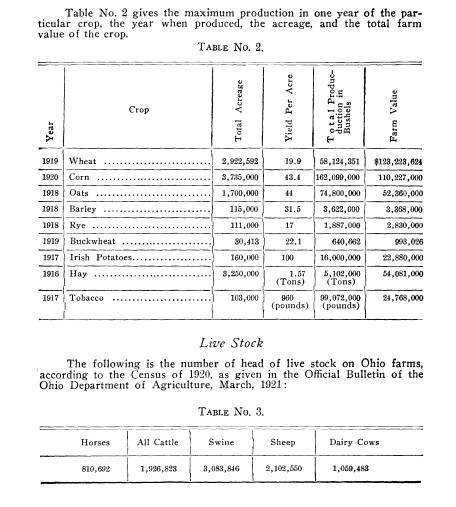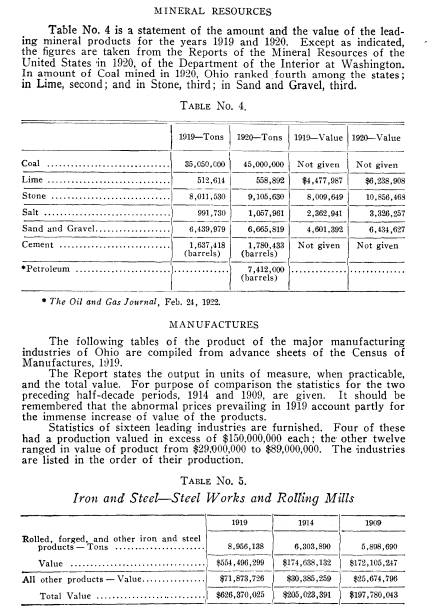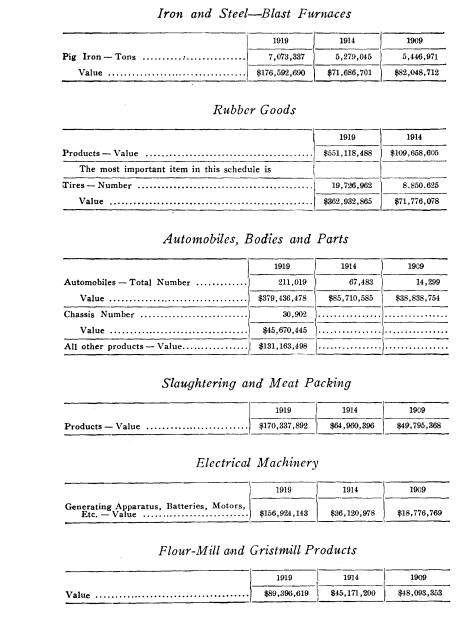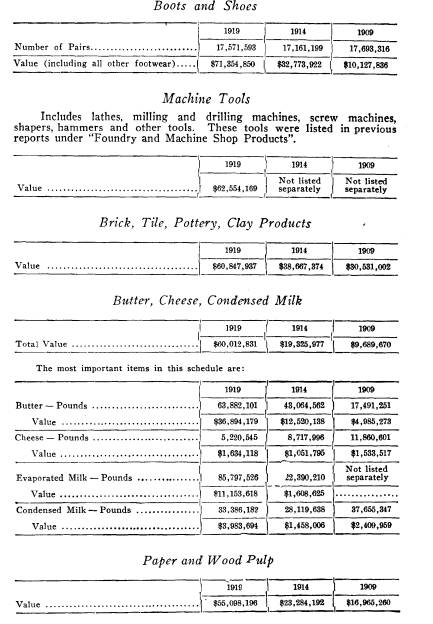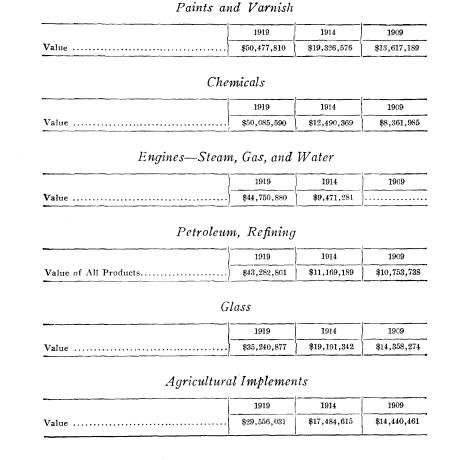Ohio History Journal
OHIO AND WESTERN EXPANSION
BY PROFESSOR WILLIS ARDEN CHAMBERLIN,
DENISON UNIVERSITY
Wonderful opportunity, matched by
daring enter-
prise, - that is the formula to account
for the mar-
velous development of the Buckeye
State. The growth
of Ohio is the epitome of national
expansion. Its
transformation from the wilderness, in
which roamed
savage Redmen and wild beasts prowled,
to the present
well-ordered commonwealth, is the epic
of American
civilization.
Ohio was the first orderly step in the
"winning of
the west." Though Kentucky and Tennessee were
settled earlier by the adventurous
backwoodsmen, that
movement was spontaneous and
unorganized. The oc-
cupation of the territory north of the
Ohio, however,
was by arrangement of Congress. Principles of or-
ganization were laid down, which have
been followed
in the opening of all subsequent
territory. The rise of
Ohio is typical in many respects of the
expansion of
the middle west. The same difficulties
faced the early
colonists; similar agencies and forces
were operative
in all of these young communities. Ohio
had the start
of the others in time. It possessed
also great natural
advantages in location and varied
resources, which have
given it precedence in many ways. The pioneers of
Ohio solved the problems that
confronted them and
devised policies that have served as
examples to the
(304)
Ohio and Western Expansion 305
newer states. So wisely were the foundations of the
young commonwealth laid by the fathers
that succeed-
ing generations have needed only to
build along the
original lines to rear a worthy
structure. The young
state has risen to a star of the first
magnitude in the
galaxy of the Union.
Statehood was achieved in 1803, when
Ohio was
received into the Union, the first of
the group of states
formed from the Northwest Territory.
The new com-
monwealth embraced the territory
between Lake Erie
and the Ohio river. It was
approximately 200 miles
each way and covered an area of 41,000
square miles.
It was a prize wrested successively
from the Redmen,
the French and the English. Washington
and many
lesser heroes had a part in this
conquest. On their
efforts hung the destiny of the
continent.
CHARACTER OF THE PIONEERS
It was no accident that the new commonwealth rose
so rapidly in population and
prosperity. Natural and
economic forces, as definite in their
effect as physical
laws, account for this
achievement. The foundations
of prosperous growth were laid in the
character of the
pioneers. The founders of the new state were from
the best people of the eastern states.
They were robust
in body and equally strong in moral
character. Many
Revolutionary heroes were among
them. They were
intelligent, experienced,
self-reliant. Many of them
were well educated and made the
beginning of educa-
tion and religious life in the West.
Massachusetts sent
the first colony to Marietta, in 1788,
under the leader-
ship of Manasseh Cutler. "No colony in America,"
Vol. XXXI-20.
306 Ohio Arch. and Hist.
Society Publications
said Washington, "was ever settled
under such favor-
able auspices. .
. .Information, property and
strength will be its
characteristics. I know many of
the settlers personally and there never
were men better
calculated to promote the welfare of
such a community."
Cincinnati, Dayton, Chillicothe and
Cleveland were
founded in the next few years and
became centers of
population for people from New Jersey,
Virginia, and
Connecticut. Many accessions from the
thrifty Scotch-
Irish and the sober Pennsylvania
Germans filled up the
eastern part of the state. Of the Western Reserve,
which was settled by pure New England
stock, it was
said by B. A. Hinsdale: "No similar
territory west of
the Allegheny Mountains has so
impressed the brain
and the conscience of the
country."
Added to these moral elements of the
pioneers were
material gifts unstinted in amount. In
the virgin soil
lay agricultural and mineral wealth of
inestimable value,
waiting only for human hands to
develop.
ADVANTAGEOUS LOCATION
The advantageous location of the Ohio
country as
the middle ground between the East and
the West was
recognized by statesmen, when western
expansion was
first considered. The Ohio River furnished an easy
avenue of trade with the Southwest, and
it was a serious
question whether the trade of this
interior territory
would not follow the line of least
resistance, instead of
flowing eastward to enrich the Atlantic
states. Wash-
ington was one of the first to realize
the economic im-
portance of this western region, and he
urged repeatedly
the construction of a road by way of
the Potomac or
Ohio and Western
Expansion 307
James Rivers and
thence over the mountains of his
native state to the
Ohio, to unite the two sections. "It
has long been my
decided opinion," he writes to Gov-
ernor Benjamin
Harrison, "that the shortest, easiest,
and least expensive
communication with the invaluable
and extensive country
back of us would be by one or
both of the rivers of
this state." He urges the
political
necessity of applying
the "cement of interest to bind all
parts of the Union
together by indissoluble bonds."
"Smooth the
road, and make easy the way for them,"-he
says, "and then
see what an influx of articles will be
poured upon us; how
amazingly our exports will be in-
creased by them, and
how amply we shall be compen-
sated for any trouble
and expense we may encounter to
effect it." Washington did not live to see his plan
realized. But it bore fruit later in influencing
Jeffer-
son, when President,
to approve the construction of the
Cumberland Road. The
two pioneer routes, either by
the Mohawk Valley and
Lake Erie, or overland to the
Ohio River, are the
basic lines for all the present compli-
cated highways of
commerce between the interior and
the seaboard. Hundreds of millions of dollars have
been expended by
public and private enterprise, to
deepen the rivers and
harbors, to dig canals and build
railroads. Ohio has been the beneficiary of these im-
provements.
OHIO THE CENTER OF AN
INLAND EMPIRE
For more than a
century the tide of settlement has
swept westward,
carrying a constant stream of popula-
tion into the
interior states. This movement has
brought out the
natural advantage of Ohio, which has
308
Ohio Arch. and Hist. Society Publications
long since ceased to be considered the
backdoor of the
populous East, but the gateway to the
vast inland em-
pire of the West. More than one-half of the popula-
tion of the United States and Canada
lies within a day's
journey of Ohio. With its pivot on
Columbus, a needle
500 miles long would cover in its sweep
the largest cities
and the most populous states in the
Union. Its eastern
tip would rest on New York and Philadelphia.
Sweep-
ing northward it would cover Rochester,
Buffalo,
Toronto and Detroit, pass Chicago on
the west and
touch the Mississippi at St. Louis,
Baltimore, Washing-
ton, and Atlanta would be included in
its eastern and
southern curve. Ohio is the center of this imperial
domain lying between the Ocean and the
Mississippi.
Into this rich territory Ohio pours the
floods of her agri-
cultural, mineral and industrial
wealth. This modern
Ceres laves her crown in the waves of
Lake Erie, plants
her footsteps amid the hills of the
Ohio, and extends
her bounties on either side, to the
crowded cities of the
eastern seaboard and to the far-flung
line of the western
horizon.
ACCESS TO MARKETS
But the problem in early years was how
to get the
goods to market. The cost of transportation was pro-
hibitive. The rise of Ohio as a commercial power
sprang from the development of new
means of trans-
portation. The aid of the National
Government was
happily gained for this object. The
first step in internal
improvement was taken in the
construction of the Na-
tional Road from Cumberland, Maryland,
to Columbus,
Ohio.
Its effect upon commerce was quickly felt.
Canals and water ways were the next
steps. Only a
Ohio and Western Expansion 309
narrow watershed separates the Ohio and
Mississippi
systems from the St. Lawrence
basin. Several rivers
flowed on either side and offered
practicable channels
for trade. It remained to bridge the
moderate height
of land by a series of locks, in order
to connect the Lake
with the river and open a passage to
the interior. Two
extensive canal systems were projected
and gradually
completed: the Ohio Canal between Cleveland and
Portsmouth, built 1825-32; and the
Miami Canal join-
ing Cincinnati and Dayton, and
eventually extended to
Toledo. These canal systems, with their main lines,
branches and connections, comprised
more than 900
miles of waterways. Their influence in stimulating
traffic cannot be overestimated. But
long before these
canals were completed the age of steam
dawned. The
railroads began to stretch out their
iron fingers in all
directions after the nation's
commerce. Gradually the
canal systems languished before their powerful
rivals.
The barges rotted at the banks and the
lock gates were
constantly open. Even yet the old channels, choked
with weeds, and the ruins of the old
locks, can be seen
in many places.
AGRICULTURAL WEALTH
With transportation provided to eastern
markets
came the era of agricultural and
commercial develop-
ment. Farming was the basic industry
and is even yet
the basis of the state's prosperity. In
spite of her rela-
tively small area, Ohio stands among
the half-dozen
leading states in the value of her farm
products. Na-
ture has been very generous with her
bounties. Ages
before the advent of man, nature was
active in shaping
the surface of this state and in
filling the soil with
|
(310) |
Ohio and Western
Expansion 311
fertility. The
glaciers of the Ice Age, in their ponder-
ous forward movement,
smoothed off the rugged fea-
tures. They carried
masses of alluvium, which were
deposited by the
melting of the ice to form the broad
terraces of rich soil
along the streams. The total
land
area of the state is
26,073,600 acres. Over
seven-
eighths of this area
are comprised in farm lands. The
whole number of farms
is more than 256,000, and it is
significant of the
high class of the rural population, that
more than two-thirds
of these farms are owned by the
men who operate them.
Ohio with its limited
size does not vie with some of
the western states in
the production of wheat, yet it can
be depended upon to
yield a large supply of this neces-
sary food. In 1919,
when the world looked to America
for food, Ohio
farmers turned more than 58,000,000
bushels of wheat into
the national granary. Corn is
the largest crop both
in acreage and in yield. The aver-
age crop is around
150,000,000 bushels. Hay is an-
other staple. Oats
and other grains are grown in abun-
dance. Ohio farms are notable for the variety of
products grown. Even
special crops, as tobacco, onions
and sugar beets,
flourish in particular localities.
HORTICULTURE
"And his black
eyes shone through the forest-gleam,
And he plunged young
hands into new-turned earth,
And prayed young
orchard boughs into birth,
And he ran with the
rabbit and slept with the stream.
And so for us he made
great medicine
In the days of
President Washington."
So sings Vachel
Lindsay in his recent epic poem in
praise of
"Johnny Appleseed," the first orchardist in
312 Ohio Arch. and Hist.
Society Publications
this section, whose eccentric habit of
strewing apple
seeds wherever he went gained for him
this sobriquet.
He owned a farm near Ashland, on which
he had a
nursery of apple trees. Some of his
trees are still bear-
ing fruit, though nearly a hundred
years old. From
present developments he is shown to be
not so simple as
his contemporaries thought, but a man
with a clear faith
in the future. His hobby of fruit raising has become
a profitable part of Ohio
agriculture. Many fruit
growers are finding this state an ideal
place for their
business. Some large orchards of apples date back
sixty to seventy years, but it is the
recent scientific
methods of spraying and culture that
have made them
profitable. The hillsides of Lawrence County seem
specially favorable for production of
apples, but no part
of the state has an exclusive interest.
The northern part along the lake is one
of the best
peach and grape growing regions in the
country. The
tempering influence of the large body
of water on the
climate is just what is needed to
protect the sensitive
fruit from the severe cold. The soil
also, impregnated
with lime, is peculiarly adapted for this
culture. Mile
after mile along the ridges are covered
with vineyards,
with their purple clusters, and marked
with peach or-
chards.
CATTLE AND SHEEP
Stock raising in all its branches is
well represented
in Ohio. The country-side is dotted
with grazing cattle,
and flocks of sheep are seen on many
hillsides. The
colonists from New England, who were
accustomed to
sheep on their rugged farms back home,
brought this
industry into Ohio. Sheep and wool were
a large com-
Ohio and Western Expansion 313
modity during two-thirds of the last
century. But the
sheep industry has declined in recent
years, though Ohio
still raises more sheep and wool than
any other state of
her class.
MINERAL WEALTH
"The industrial importance of Ohio
is due in great
measure to its natural resources."
This is the state-
ment of the government report, which
continues: "The
state ranked fourth in 1914 in total
value of mineral
products, first in output of clay
products, fifth in
quantity and fourth in value of coal,
fourth in
quantity and third in value of natural
gas, and
seventh in output of
petroleum." These mineral de-
posits are of the most useful kinds and
are distributed
throughout all parts of the state. Salt
was the first of
these products to be used
commercially. In several
places salt licks were found, which
even before the com-
ing of the white men were favorite
haunts of the buffalo
and the Redmen. Iron was discovered in
paying quan-
tities and many blast furnaces were
erected in the early
decades of the last century for the
reduction of iron ore.
Limestone is another valuable building
product found
in several localities The State Capitol
is of limestone
from a quarry near Columbus. Sandstone underlies
much of the northern part of the
state. The quarries
about Berea are famous for their
supplies of building
and paving stones.
COAL
But the state is especially rich in one
of the essen-
tials of modern life, -coal. Strata of coal lie near
the surface and may be seen cropping
out in some places
along the sides of railroad cuts.
Geologists tell us that
314
Ohio Arch. and Hist. Society
Publications
ages ago southeastern Ohio was covered
with an inland
sea, whose shallow and marshy shores
were filled with
dense vegetation. In later ages this
luxurious growth
of vegetation was covered with
sedimentary rocks and
subjected to great physical and
chemical processes,
which gradually transformed it into
high grade bitu-
minous coal. In the coal seams are
occasionally found
the trunks of trees and even their
leaves and spores, car-
bonized into the best of fuel. Ten thousand square
miles of the state's surface are
underlain with coal.
The richest bed is the Pittsburgh seam,
which Professor
F. Carney, a geologist, called
"the most famous horizon
of coal in the Appalachian
region."
Besides providing for local consumption
the Ohio
mines are relied upon to supply a large
part of the fuel
for the West and Northwest. The coal shipments to
the upper lakes reach annually immense
proportions.
Several lines of railroads cross the
state, whose chief
business is the transportation of coal
from the mines
to the lake ports. When a coal famine
threatened the
Northwest in 1920, the Ohio mines were
speeded up to
avert the danger. Some 3000 to 4000 car
loads of coal
per day were delivered, were poured a
carload at a time
into thecapacious holds of the lake
carriers and rushed
to the upper lakes. Thus the threatened shortage was
avoided.
NATURAL GAS AND PETROLEUM
About thirty-five years ago natural gas
was obtained
in sufficient quantities in Ohio for
commercial purposes.
Its presence in salt wells and in other
places had been
noted much earlier. The first wells
were shallow and
yielded only enough gas for domestic
use. But when
Ohio and Western Expansion 315
deeper wells were bored, larger
"pockets" were pierced,
which released great volumes of gas. It
gushed forth
with such violence as frequently to
hurl the heavy drills
out of the borings with a roar that
could be heard for
miles. Wells flowing from 3,000,000 to
5,000,000 cubic
feet per day were common. The Clinton sand has
proved to be one of the most productive
gas reservoirs
of all the world. It underlies an area
extending from
the shore of the lake southward almost
to the Ohio
River. The maximum production of gas in
Ohio was
reached about ten years ago, when it
exceeded 56,000,-
000,000 cubic feet for the year.
Several large wells
flowed at first at the rate of 12,000,000
feet or even 15,-
000,000 feet per day, and one drilled
in Wayne County
in 1915 poured out the gas at the rate
of 22,000,000
cubic feet per day. Gas was consumed
with prodigal
wastefulness at first, as if the supply
were inexhaustible.
After a few years producers learned
better methods of
controlling the flow. New fields were
discovered, and a
reliable supply of gas for domestic and
industrial pur-
poses has been furnished to many cities
during the past
twenty-five years. But experts declare
that the supply
is rapidly failing.
Oil is found in abundant supply at many
places in
proximity to gas. Oil producing territory was first
developed in the eastern counties. But the flow was
small compared to the volume coming
from the Lima-
Marion pool more recently discovered.
This field ex-
tends in a southwesterly direction from
Lake Erie to
Marion, Indiana. The belt is twenty
miles in breadth
in some places. The oil is found in the
Trenton rock
at a depth varying from 1,000 to 1,500
feet. From the
316
Ohio Arch. and Hist. Society Publications
Ohio field alone over 25,000,000
barrels of oil were pro-
duced in one year.
MANUFACTURING IS THE FOREMOST INTEREST
With its wealth of natural resources
and its loca-
tion at the center of the most populous
section of the
Union, it is not strange that
manufacturing has become
the chief industry of the state. The progress in that
direction is marked by tremendous
strides. The state
ranks fourth among the states in the total
value of
manufactured products, and third in the
number of
wage earners. The expansion of Ohio's industries in
the last half-decade, 1914-19, is
unparalleled. During
that period the value of manufactures
in the state in-
creased 185 per cent, to a total volume
of $5,100,299,000.
A further evidence of industrialism is
the increasing
proportion of the population gathered
in cities and
towns.
Ohio ranks first in several different
lines of manu-
facture; especially rubber goods, clay
products, stoves,
and the glass industry. It takes second
place in several
other of the biggest industries, such
as manufacture of
automobiles, and of steel and iron
products. Not only
in the bulk of manufactured products,
but especially in
the variety, the state is
remarkable. Of the 356
branches of industry in the United
States, classified by
the Census, 302 branches were
represented in this state.
Lying between New York and
Pennsylvania, the
largest producers of the East, and
Illinois the greatest
in the West, and with the best markets
of America
within a day's distance, Ohio is at the
center of the in-
dustrial and commercial life of the
United States. Her
Ohio and Western Expansion 317
constant outgoing streams of materials
and manufac-
tured products are currents of power to
energize the
vast machinery of American
industry. Ohio is the
dynamo of national commerce and
industry.
WATERWAYS
Ohio owes its phenomenal rise as an
industrial
power to its unrivaled waterways. The Ohio River,
with its course of 436 miles along the
southern border,
and Lake Erie on the north provide two
avenues of con-
nection with the world. Hulbert, the historian of the
Ohio River, calls it "a strategic
avenue of national ex-
pansion," and "one strategic
course of empire to the
heart of the continent." The story of "the beautiful
river" is full of romantic
charm. Around its banks
were waged the fierce conflicts between
the Redmen,
French, English and Americans for the
possession of
the heart of the continent. On its
placid surface it bore
first the birch bark canoe, sometimes
filled with dusky
warriors but more often on peaceful mission
bent, skim-
ming light as a feather over its waves.
Then came the
flat-boats and keel boats, floating the
hopeful colonists
to their new homes, or loaded with corn
and bacon for
commercial ventures in Southern
markets. Lastly
echoed the hoarse voice of the steamer
among the hills,
symbol of the new age of invention.
The traffic on the Great Lakes
developed later, but it
has risen to far greater
proportions. The rapid ex-
pansion of this traffic is due to the
building of the Sault
Canal.
"No single accomplishment in a constructive
way has 'meant so much to water-borne
commerce as
the building of this canal," is
the opinion of one writer.
318
Ohio Arch. and Hist. Society Publications
The discovery of the unlimited deposits
of iron ore in
the Lake Superior region, and the
enormous demand
for iron and steel, have been the
motive forces in the
growth of lake transportation. For several years the
shipments of iron ore have exceeded
60,000,000 tons
annually. Figures give the faintest conception of the
mountains of ore that are yearly dumped
upon the docks
of Lake Erie. Many of the steel boats used in this
trade would make an ocean ship look
small. Ore car-
riers 500-600 feet long are common. To
accommodate
these leviathans, old harbors have been
reconstructed.
New docks have been built, extending
into the lake,
protected by breakwaters, walls of
cement and steel.
They are provided with the most
powerful loading and
unloading machinery in the world. The hydraulic
elevators lift a car-load of coal every
two or three min-
utes and pour its contents into the
gaping holds of the
steel freighters. Correspondingly powerful electric
cranes lift the iron ore in great
buckets, convey them to
the dock to the desired position, and
dump the ore in
mountainous piles that accumulate for
the following
winter. A cargo of 10,000 tons can be unloaded
in two
hours. These wonderful machines are so
carefully ad-
justed in their mechanism that their
operation resembles
the groping of human hands and the
lifting of giant
arms perform the labor of ten thousand
men. They
are Ohio-made.
THE STEEL INDUSTRY
Economic forces have destined Ohio for
a leading
position in the iron and steel
industry. Her unique
location between the richest iron mines
of America and
the vast coal deposits gives to this
state a most advan-
Ohio and Western Expansion 319
tageous position for the production of
iron and steel.
Eastern Ohio, where the two commodities
meet, is
ablaze with furnaces pouring out their
molten masses
night and day to gird the continent.
Iron is found in small quantities in
Ohio and the
iron business dates from early
days. The first blast
furnace was erected in 1804 near
Youngstown, and it
was followed by several others in the
next few years.
They used the iron and limestone found
in the Mahon-
ing Valley and had a daily output of
from two and one-
half to three tons. The discovery of
the Lake Superior
mines, however, was the decisive
influence in the estab-
lishment of the giant industry of
modern times. The
blast furnaces are the most picturesque
feature of the
steel mills. Like huge infernos they
shoot their flames
high in the air with a roar like the
howls of condemned
spirits, and lighting up the heavens
with a baleful glare.
In the rolling mills the rough ingots
of steel are heated
to white heat and then are run between
great rollers,
which exert enormous pressure upon the
steel and re-
duce it to the desired shape, whether
it be steel rails,
girders, wire or flat bands.
THE MARVEL OF RUBBER
Second only to iron and steel in its
usefulness in
daily life comes rubber. It enters into a thousand
necessaries of human beings. It has
made possible the
tremendous expansion of industry in
recent decades, not
only by its direct contributions to
transportation, but
also by numberless indirect means.
That rubber can be transformed from a
black, sticky,
shapeless mass into elastic bands,
flexible clothing, hard
320
Ohio Arch. and Hist. Society Publications
and resilient tires, buoyant airships,
and into a sub-
stance capable of polish like steel,-
these transforma-
tions are the miracles of every-day
life. The use of
rubber in a general way sprang from a
fortunate acci-
dent, by which the process of
vulcanization was dis-
covered. By this process the crude material is
hardened, so that it is no longer
sensitive to heat and
cold. The phenomenal rise of the rubber
industry be-
longs to the last fifty years. By
another fortunate cir-
cumstance the infant industry was
located at Akron,
when the pioneer factory was brought
there through
the enterprise of a far-seeing citizen
of that city. The
beginning was modest, but out of it has
developed the
second largest industry of the United
States. Akron,
"the rubber city," has risen
from a town of 10,000 peo-
ple to one of the chief cities of the
state, with a popula-
tion exceeding 200,000.
RUBBER TIRES
Rubber has revolutionized
transportation by its use
for tires on vehicles. Thirty years ago
rubber tires for
bicycles and carriages constituted the
chief use of this
material. Then the invention of
pneumatic tires led the
way to the manufacture of automobile
tires. Without
the inflated tire, the automobile would
never have been
practical for rapid locomotion.
Conversely, the unpar-
alleled increase in the number of motor
vehicles ac-
counts for the marvelous strides of the
rubber business.
The pioneer plant of fifty years ago
has grown perhaps
a hundredfold, while many similar
plants have been or-
ganized in Akron and adjacent cities.
Some of these
plants have capacity for turning out
more than 30,000
Ohio and Western Expansion 321
tires a day. It is estimated that Akron
supplies sixty-
five per cent of all tires. Naturally
Ohio has first place
in the rubber industry.
Although tires comprise the bulk of the
rubber man-
ufacturing, there is almost endless
variety of other
articles. One plant lists 30,000
different articles which
it produces.
RUBBER HELPED WIN THE WAR
There was no single material, aside
from the actual
weapons and munitions of warfare, that
was so indis-
pensable in the war as rubber. In this particular one
thinks first of the millions of tires
on automobiles,
trucks, ambulances and airplanes. Then
came rubber
garments and rubber footwear for the
soldiers. The
rubber gas masks were absolutely
indispensable and
were a triumph of inventive genius in
combating a new
danger. Of almost equal importance were the tele-
phones and telegraphs, in which rubber
was used for
insulating and in the instruments.
The demand for observation balloons,
airships and
dirigibles produced a new industry in
rubber manufac-
ture.
One of the secrets of the war is that Akron
plants produced over 900 balloons and
dirigibles during
the war. This city has the only
complete plants in the
country for the manufacture and testing
of lighter-
than-air craft.
If to all these necessaries, directly
connected with
the fighting, we add the multitude of
surgical appliances,
in which rubber is an essential part,
and which were
vitally important in the care of the
wounded, it is not
too much to say, that rubber was an
essential element
in winning the war.
Vol. XXXI-21.
322
Ohio Arch. and Hist. Society
Publications
OTHER MANUFACTURES
Ohio is closely identified with the
manufacturing of
automobiles. The first automobiles produced for sale
were made in a Cleveland factory. The
state has kept
pace with the rising industry and is
the second largest
producer of automobiles in the
country. It is also a
large producer of automobile parts,
which is a distinct
and prominent branch of manufacturing.
Dayton is known the world round as the
home of
the National Cash Register. Here has been built up
a great enterprise, whose product is an
almost indis-
pensable aid to business. The plant where the cash
registers are made is no less
remarkable than the ma-
chine, almost human in its
performances. Other in-
struments of measurement and
calculation are made at
Dayton.
The center of the manufacture of clay
products is
located at East Liverpool. Many plants are located
in and around this city, turning out
large quantities of
useful and decorative pottery
ware. Porcelain,
crockery, and ornamental articles of
various kinds give
this city a wide reputation. Other
extensive potteries,
whose products are well known, are
situated at Zanes-
ville and Cincinnati.
Clothing manufacturing has grown
rapidly in Ohio
during recent years and bids fair to
become one of the
leading lines of production.
Even a hasty review of the many lines
of Ohio man-
ufacture would exceed the bounds of
this article.
|
(323) |
324 Ohio Arch. and Hist.
Society Publications
NATIONAL LEADERSHIP
After all, the material features are
but the frame of
the picture. The brightest page of Ohio history is the
people themselves. In the wonderful prosperity of the
state they are the chief asset. Their
distinction brings
the state into national
prominence. Without reference
to the present administration, in which
the predomi-
nance of Ohio men awakens almost the
envy of sister
states, Western men in general and Ohio
men in many
instances have been the controlling
forces in national
affairs. With its glace forward, not backward, the
West is the parent of reform, the
champion of progress.
SPIRITUAL FORCES
The explanation of this distinction is
found in the
spiritual forces which have determined
the character
of these people. Descendants of the best American
stock, reared in moral principles, they
have a splendid
endowment of virtue and intelligence.
They look upon
the Ordinance of 1787 as the Magna
Charta of their
civil liberty. It established the
principles that are now
accepted everywhere in the Union as
fundamental, but
which were first applied on a large
scale to the North-
west Territory. The Ordinance proclaimed religious
toleration, prohibited human slavery,
encouraged reli-
gion and education, and declared the
complete union of
the state with the National
Government. These are
the ideals of political and moral life
that Ohio people
cherish as dearly as life.
As is fitting for the first state
organized as a ward
of the Federal Government, Ohio, like
all of those of
the Central West, has been most loyal
to the Govern-
Ohio and Western Expansion 325
ment in the stress of war. Her people
have been quick
to respond to the Nation's call both
for men and for
money and all comprehended under the
term "sinews
of war." This is Roosevelt's comment on this fact:
"The mighty and populous
commonwealths that lie north of
the Ohio and in the valley of the upper
Mississippi are in a
peculiar sense the children of the
National Government, and it is
no mere accident that has made them in
return the special
guardians and protectors of that
Government, for they form the
heart of the Nation."
PUBLIC SCHOOLS
Probably no single force has been so
influential in
moulding Ohio's history as the system
of free public
schools. Fostered at first by the
National Government,
carried on later by the state itself,
education has been
a passion with these people, which
neither the hardships
of pioneer homes nor the press of
sterner duties could
extinguish.
No other enterprise enjoys such a
degree of popular
confidence as the public schools. Each year they re-
ceive millions of dollars for current
expenses, and the
value of permanent school property runs
into the hun-
dreds of millions. A million pupils are enrolled this
year in Ohio schools, and nearly 35,000
teachers are
engaged in instructing this army. But
more significant
than these figures is the improvement
in the personnel
of the teachers and in the character
and numbers of
scholars entering the higher
grades. The new school
code, adopted 1914, raises the
standards required of
teachers. Intending teachers are encouraged to take
a large amount of professional study,
which is accepted
in place of an examination.
326 Ohio Arch. and Hist. Society
Publications
TOWNSHIP SCHOOLS
A progressive movement
is seen in the centralized
township schools, that
are taking the place of the small
rural schools.
"The most outstanding feature of edu-
cational progress in
the state in the last ten years," says
George M. Morris,
State Superintendent of Rural
Schools, "is
without any doubt the consolidation and
centralization of the
rural township schools. Largely
as an effect of this
movement the attendance of the high
schools has increased
about fifty per cent, and the sani-
tary and health
conditions of the homes and schools are
improved." There
are now about a thousand consoli-
dated or centralized
schools. Many of them are models
both in equipment and
in methods of instruction. In
them educational
advantages equal to those in city
schools are available
to country children. The propor-
tion of pupils
entering the high schools has been largely
increased and about
twelve and one-half per cent of
high school graduates
continue their courses in colleges.
OHIO THE MOTHER OF
COLLEGES
The state is famous as
the home of many colleges.
The first one was
founded in 1804, one year after
statehood was
achieved, on the grant of two sections of
land, at Athens. It
was the child of the New England
colony. It is still flourishing as Ohio University.
Many private colleges
were founded during the next
half century,
representing all the leading religious de-
nominations. There are several state and municipal
institutions. Forty colleges in different parts of
the
state testify to the
people's interest in higher education.
In respect to her care
for the helpless and dependent
Ohio and Western Expansion 327
classes, Ohio is making a generous
record. Her benevo-
lent and correctional institutions are
twenty in number,
placed under the Department of Public
Welfare. The
annual reports of these institutions
will convince any-
one that the state is making strenuous
efforts for the
care of the dependent classes.
The state is increasing its oversight
of vital condi-
tions by the cooperation of state and
local authorities.
Recent legislation provides for
district health officers
and public nurses. A bureau of vital statistics is in
operation. The health of school children is carefully
looked after. Standards of health are being estab-
lished and the people are being
educated to care more
scientifically for the physical welfare
of themselves
and their families.
HOME ENVIRONMENT
The best indication of the people's
welfare is to be
found in their domestic arrangements.
What are their
standards of living? Are their homes
furnished with
conveniences and with labor-saving
devices? In short,
what is their home environment? In this respect the
people of Ohio have reason for great
satisfaction, for
their surroundings have improved in
proportion to their
material prosperity. The outstanding fact in this re-
gard is, that Ohio is a state of free
holders. No less
than two-thirds of its farms are owned
by those who
work them. The proportion of property owners in
towns and cities would doubtless be
equally remarkable.
Cleveland is proud of the fact that
thirty-five percent
of her citizens own their homes. Recent
reports credit
Columbus with a slightly larger per
cent of home
owners.
328
Ohio Arch. and Hist. Society Publications
As to household conveniences, they are
the rule now
in cities and towns. Sanitary fixtures, electricity and
gas for lighting and heating,
telephones and machinery
for household work are common in these
homes. But
the dwellers in the country have been
especially bene-
fited by these modern inventions,
through which the
isolation of country life has been
overcome. Over
sixty-two per cent of country homes in
Ohio have tele-
phones. One in six of these rural homes has water
piped into it, and one in seven is
lighted with gas or
electricity. Rural mail delivery reaches practically
every farm in the state once a day.
The intelligence and prosperity of the
rural commu-
nities are reflected by the equipment
of machinery and
appliances. Automobiles, trucks and
tractors are rap-
idly supplementing horse power on Ohio
farms. There
are over 128,000 automobiles and 10,000
tractors on
these farms.
IMPROVED ROADS
Perhaps no improvement in the last ten
years is of
greater economic value than the
improved roads. Great
activity is shown in this
direction. Federal, state and
local authorities cooperate in the
movement. The old
National Road, which was in a ruinous
condition, was
one of the first highways to receive
attention. It has
been graded and paved the whole breadth
of the state
and is one of the beautiful highways of
the country.
The so-called primary system of
highways will be
nearly completed this season. It includes seven main
thoroughfares, three east and west,
three north and
south, and a diagonal highway from
Cleveland via
Columbus to Cincinnati. 4500 miles of
improved high-
|
(329) |
330
Ohio Arch. and Hist. Society Publications
ways are already constructed and soon
all parts of the
state will be connected with rain-proof
roads.
THE LEAVEN OF EXPANSION
No mention has thus far been made of
the number
of people composing the population of
this state. It is
not surprising, from the foregoing
facts, that the popu-
lation has increased one-fifth in ten
years and numbers
five and three-fourths millions. But the amount of
population is of secondary interest. What is of pri-
mary importance is, that this army of
five and three-
fourths millions be animated with
common purposes and
inspired with noble principles. This is
the work of all of
those subtle forces, of which some of
the most obvious
have been pointed out, in the preceding
pages, forever
playing upon the plastic material of
human nature. The
influence of these forces is seen, not
only within the
bounds of this one state, but
throughout the newer
West, where the same spirit that
actuates Ohio has been
the leaven of expansion.
|
Ohio and Western Expansion 331 RESOURCES OF OHIO To show in accurate and concise form the present resources of Ohio, tabular statements of the agricultural, mineral, and manufacturing prod- ucts are here presented. The statistics have been compiled from the latest official reports, of which advance sheets have been furnished to the writer. The sources indicated supply more detailed information. AGRICULTURAL RESOURCES Statistics of the leading crops for 1921 are presented in Table No. 1. As the year 1921 was a poor year for farming, the crops show a decrease in every instance in comparison with the preceding year. To show more nearly the average yield, the figures for the year 1920 are also given.* |
|
|
|
332 Ohio Arch. and Hist. Society Publications |
|
|
|
Ohio and Western Expansion 333 |
|
|
|
334 Ohio Arch. and Hist. Society Publications |
|
|
|
Ohio and Western Expansion 335 |
|
|
|
336 Ohio Arch. and Hist. Society Publications |
|
|
